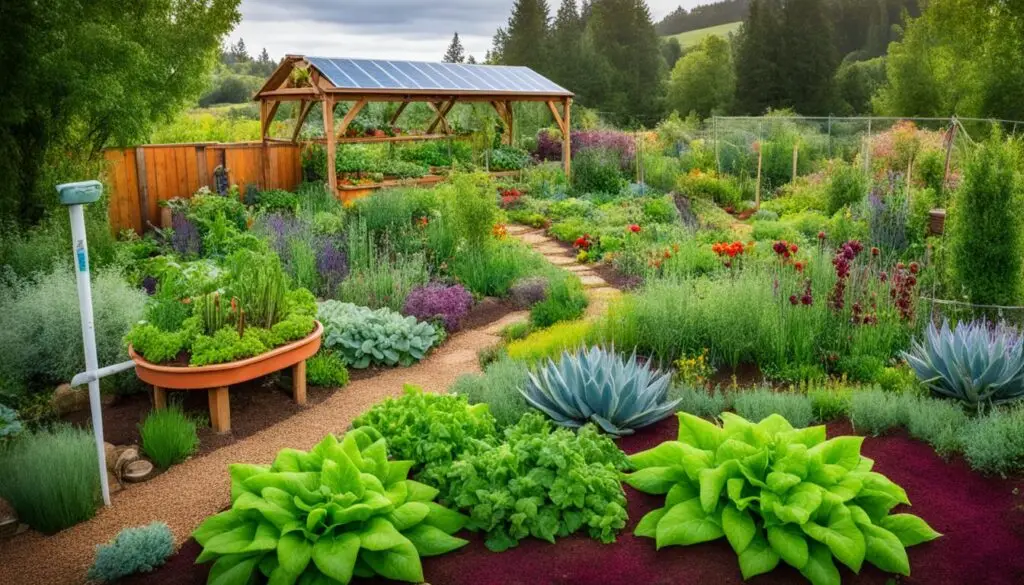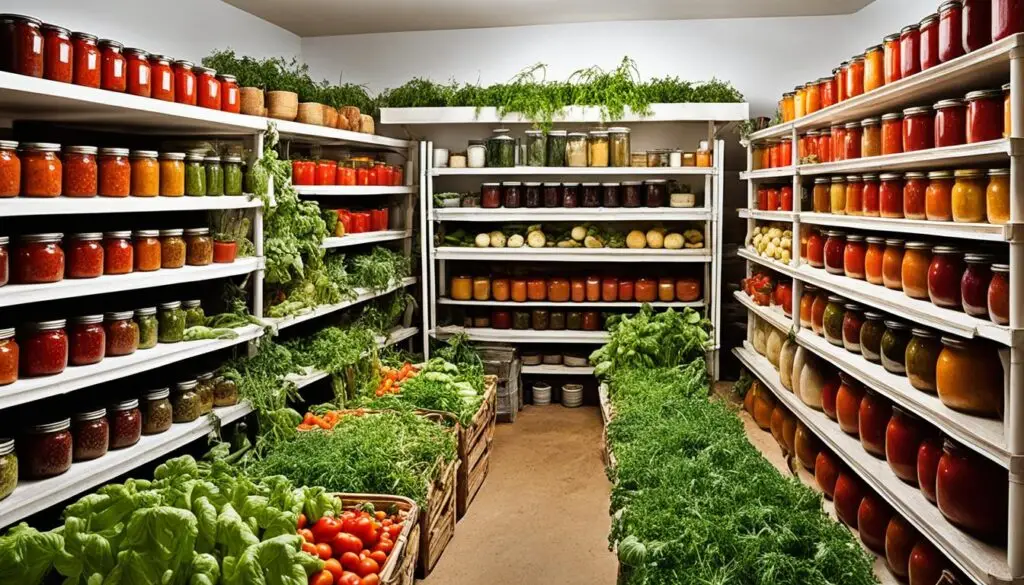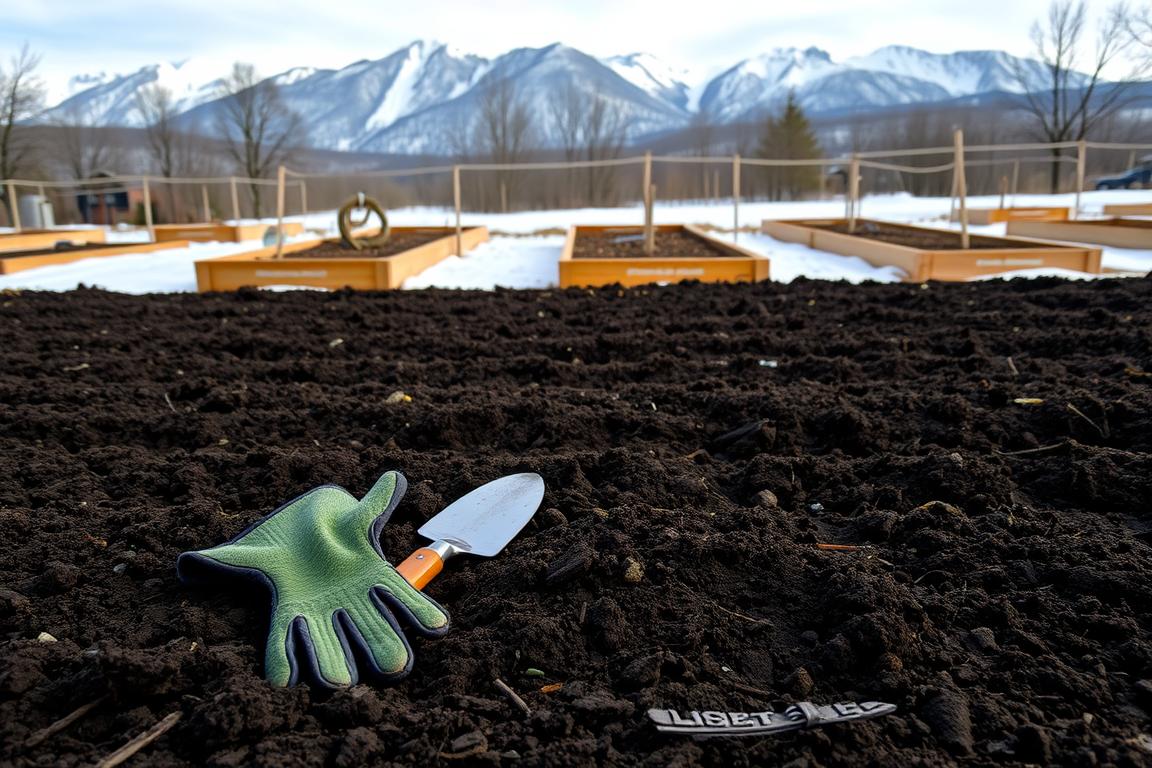Do you dislike bland store-bought produce and want to feel more connected with nature? Then, you should try gardening for abundance. This article will explore how to cultivate a bountiful garden. You’ll get valuable tips and techniques for success.
Imagine strolling through your garden. It’s full of vibrant greens, colorful flowers, and fresh fruits. Picture picking a ripe tomato and enjoying its flavors. With the right approach, your garden can be a place of plenty.
Gardening for abundance works in large yards or small balconies. It gives you fresh food, promotes self-sufficiency, reduces your environmental impact, and reconnects you with nature.
We’ll cover many ways to make your garden abundant. This includes the value of plant variety and how to use permaculture to grow more. By the end, you’ll be ready to create a garden that feeds your body and spirit.
Key Takeaways:
- Cultivating abundance through gardening offers fresh, flavorful produce and promotes self-sufficiency.
- Gardening for abundance allows you to reconnect with nature and reduce your carbon footprint.
- This article will provide tips and techniques for creating a thriving, bountiful garden.
Understanding Edible Abundance in Your Garden
Gardening for abundance is all about variety. Choosing a wide range of plants means more food and a healthier garden. It also makes your gardening more sustainable.
Cultivating a Mindset for Edible Diversity
Welcoming edible variety goes way past the usual vegetables and fruits. It’s about adding in not-so-common plants like edible flowers and herbs. You can even eat some weeds!
Taking this step helps your garden in many ways. It makes the soil healthier. It helps keep pests away naturally. Plus, it attracts pollinators, making your garden a richer place.
Recognizing Edible Parts of Common Plants
Realizing what parts of common plants you can eat is eye-opening. For instance, you can eat more than just the root of a radish. Knowing this lets you enjoy a bigger variety of foods from your garden.
Don’t forget about using parts of plants we usually throw away. Things like peels and stems can be tasty and reduce waste. This step is great for both your meals and the planet.
The Role of Edible Perennials in Sustainable Gardening
Edible perennials are important because they come back every year. This reduces the work you need to do to enjoy fresh food. Some examples include asparagus and strawberries.
Adding these plants to your garden improves the soil and supports wildlife. It creates a healthy ecosystem. This ecosystem keeps giving, year after year.
Choosing a diverse array of plants and including perennials can lead to a bountiful garden. It also contributes to living more sustainably. Next, we’ll look at using permaculture to grow even more in your garden.
Maximizing Garden Yield with Permaculture Principles
Permaculture gardening focuses on sustainability and regenerating ecosystems. It aims to achieve high garden yields while keeping environmental effects low. By following permaculture principles, you’ll harvest plentiful crops every year.
These methods promote a natural balance in ecosystems, saving resources and reducing waste. For instance, planting many kinds of plants together, called polyculture, uses sunlight, nutrients, and water better. Another method, companion planting, pairs different plants to help each other grow.
Agroforestry is a unique permaculture approach that mixes farming with forest-like planting schemes. It places trees near crops or animals to benefit both. Trees offer shelter, protect from winds, and recycle nutrients. In return, plants or animals thrive under their care.
By using permaculture in your garden, you help create a vibrant, balanced space. This space isn’t just productive, but also boosts life diversity and nature’s hardiness. Permaculture gardening is about getting the most from your garden sustainably. It’s a way to support a healthy, green tomorrow for everyone.
Gardening for Abundance by Catching and Storing Energy
Growing a garden is more than just the seeds you plant. It’s about using energy smartly to help your plants thrive. Catching and saving the right energy can lead to a garden that constantly gives back. We’ll talk about how to catch energy, manage water well, use natural benefits, and save your garden’s harvests.
Water Management Techniques for Abundant Gardens
Water is key for a great garden. Handling it well can mean more crops. There are several ways to save and use water wisely:
- Mulching helps keep moisture in the soil and stop weeds.
- Drip Irrigation gets water to plant roots without wasting any.
- Water your plants when the sun isn’t too strong to reduce water loss. Keep an eye on the soil to make sure you’re not doing it too much.
By using these methods, you make sure your plants get just the water they need. This helps them grow strong and give you plenty to harvest.
Using Natural Yields and Secondary Crops
To get a lot from your garden, use everything you can. Leaves, trimmings, and kitchen scraps can all help your soil. Here’s what to do:
- Spread leaves, grass, or straw over the soil to stop weeds and keep it healthy.
- Turn your waste into compost. This rich mix makes the soil good for growing.
- Plant some cover crops when you’re not growing main crops. They keep the soil in good shape.
By doing this, your garden uses its waste to make more food. It also keeps the soil full of important nutrients.
Preservation and Storage for Year-Round Abundance
Storing your garden’s harvest lets you enjoy your hard work any time. Better yet, it cuts down on wasted food. Here’s how to keep foods fresh:
- Put fruits and veggies in jars and heat them up to can them. This keeps them tasty and nutritious.
- Freeze fresh produce right after picking to keep the nutrients and flavors in.
- Dehydrate foods by removing water from them. They stay good to eat and are easy to keep.
By saving your crops in these ways, you make sure you always have something from your garden to eat. This is true even in times when you’re not growing.
| Preservation Method | Advantages | Disadvantages |
|---|---|---|
| Canning | – Long shelf life – Retains nutritional value |
– Requires equipment – Time-consuming |
| Freezing | – Retains color, flavor, and texture – Convenient |
– Requires freezer space – Can affect texture of certain produce |
| Drying | – Lightweight and portable – Long shelf life |
– Some loss of nutritional value – Requires time and proper storage |
Landscaping for Abundance: Structuring Your Garden for Success
Creating a well-structured garden is key to abundance and success. Think about sunlight, soil, and where you put plants. This helps your garden be more productive and successful.
It’s vital to have different areas for various plants. You might want vegetable patches, fruit trees, and flowers. This separation makes your garden more productive and beautiful. It also helps you take care of plants better.
Using vertical gardening helps when you have limited space. Trellises and espalier can train plants to grow up. This uses space efficiently and makes your garden look interesting.
When you plan your garden, think about both looks and use. The layout, pathways, and adding things like seating matter. These details make your garden look good and easy to enjoy.
Knowing about landscaping can help you create a stunning and productive garden. With the right design, your garden will flourish. You’ll enjoy plenty of fruits and flowers.
| Garden Structure Benefits | Garden Design Tips |
|---|---|
| Optimizes sunlight exposure | Create functional garden zones for different plant types |
| Enhances soil quality and fertility | Incorporate vertical gardening techniques to maximize space |
| Facilitates easy plant maintenance and access | Balance functionality and aesthetics in the overall garden layout |
Abundance Gardening Techniques: Soil, Sunlight, and Water Optimization
To get a lot of fresh fruits and veggies from your garden, focus on three things. These are soil, sunlight, and water. Here’s how to make them work best for your plants.
Improving Soil for Abundant Harvests
Good soil is key to a successful garden. Here are some tips to boost your soil’s quality:
- Start Composting: Mix kitchen scraps, yard clippings, and leaves to make rich compost. Adding compost to your soil makes it better for plants.
- Try Crop Rotation: Change where you plant each crop every season. This keeps the soil healthy and wards off pests and diseases.
- Use Organic Amendments: Boost soil health by adding natural fertilizers like composted manure, bone meal, or seaweed.
Leveraging Sunlight for Maximum Plant Growth
Plants need sunlight for energy and growth. To get the most from the sun, try these steps:
- Plant Spacing: Make sure plants are not too close together. This way, each plant gets enough sunlight.
- Thinning: Remove extra plants to let sunlight in and help the remaining ones grow strong.
- Smart Plant Placement: Put tall plants where they won’t block the sun from smaller ones. Use reflective materials to bounce sunlight onto plants in shade.
Efficient Water Usage in Abundant Gardening
Water wisely for a thriving garden. Here’s how to save water while keeping your garden healthy:
- Use Mulch: Cover the soil with mulch to keep water from evaporating. Mulch also helps control weeds and keeps the ground cool.
- Water in the Early Morning or Late Evening: Best times to water are before the sun gets too hot or when it’s going down. Plants soak up water better then.
- Try Drip Irrigation: A drip system waters plants right at the roots, using water more efficiently. It keeps plants happy without wasting water.
Follow these tips to make your garden’s soil, sunlight, and water perfect for plant growth. Your garden will not only give lots of tasty foods but also help save resources and the planet.
Conclusion
In this article, we’ve looked at how to make gardens more productive. We found ways to grow diverse, edible plants and use perennials. With these methods, anyone can get more food from their garden.
The idea of permaculture helps. It’s about mimicking nature’s balance. By planting different plants together, we can work with nature. This brings more food and less waste.
Handling water and energy well is crucial, too. Saving water through mulching and drip irrigation is smart. Also, making sure the garden is efficient means more growth and less waste.
Using these tips, you can turn your garden into a bounty. Try new edible plants and use permaculture wisely. Care for the soil, sun, and water in your garden. This way, you and your family will enjoy fresh, healthy food all year.
FAQ
How can I create abundance in my garden?
To make your garden abundant, focus on a variety of edible plants. Use permaculture techniques and manage water well. Design your garden smartly. This way, you can grow more food and enjoy a lush garden.
What is edible diversity and why is it important in gardening for abundance?
Edible diversity means growing many types of food. It’s essential for a plentiful harvest. By planting different foods, you not only get more, but you also get to try new flavors.
How can I recognize the edible parts of common plants?
Some plants have edible parts that are not commonly eaten. You can learn about these parts from books, the internet, or gardening guides. It’s also fun to try these parts in your cooking.
What are the benefits of incorporating edible perennials into my garden?
Edible perennials give food year after year. They need less replanting. Plus, they don’t require as much work. This makes them great for a productive and easy-to-care-for garden.
What are permaculture principles and how can they maximize garden yield?
Permaculture is about sustainable gardening. Its principles help create a self-supporting garden. This means less work, more food, and a healthier ecosystem for your plants. It’s a win-win.
How can I catch and store energy in my garden?
Renewable sources like solar power can run your garden. Collecting rainwater saves water. Also, composting turns waste into plant food. These methods help your garden thrive with less effort.
What are some water management techniques that promote abundance in the garden?
Using water wisely is key for a lush garden. Mulching and drip systems keep moisture in the soil. Water in the morning or evening to avoid loss from the heat. This keeps your plants happy.
How can I utilize natural yields and secondary crops in my garden?
The natural things your garden produces can be re-purposed. Use them for mulch, compost, or fertilizer. This way, you feed your plants and reduce waste at the same time.
What are some preservation and storage methods for year-round abundance?
To keep enjoying your garden’s food, try canning, freezing, or drying. These methods let you savor your harvests all year. They help reduce waste, too.
How does garden structure and design affect abundance?
Good garden planning boosts your harvests. The right sunlight, soil, and layout help your plants to be more productive. With the correct design, your garden will flourish.
How can I optimize soil fertility, sunlight exposure, and water usage for abundance gardening?
Improve the soil with compost and crop rotation. Space your plants well for sunlight. Use water wisely with mulch and drip systems. These steps make your garden more fruitful and efficient.








